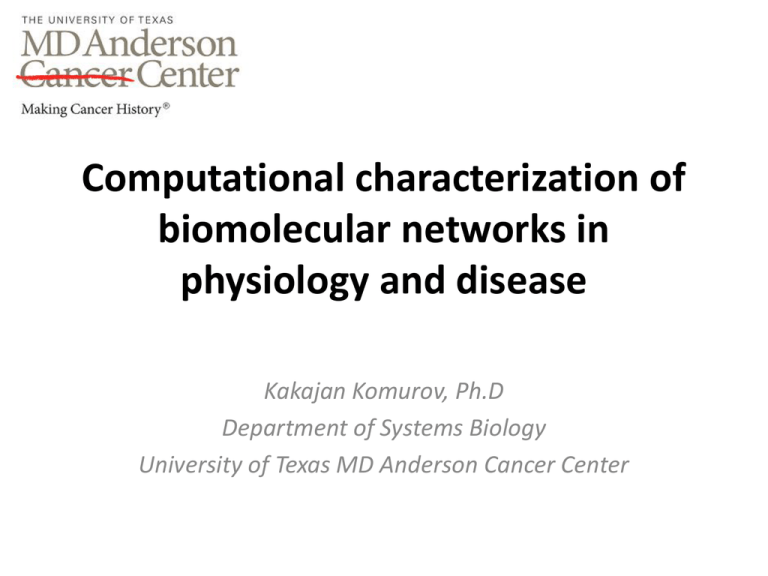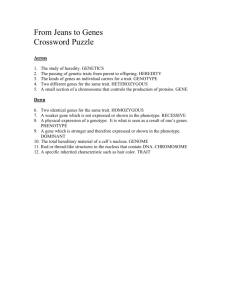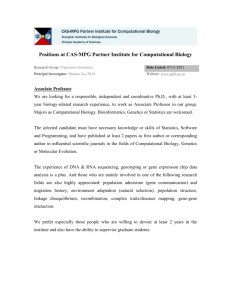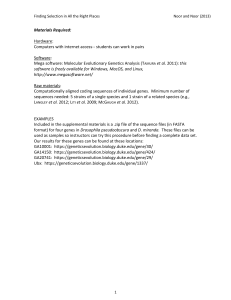Computational characterization of biomolecular networks in
advertisement

Computational characterization of biomolecular networks in physiology and disease Kakajan Komurov, Ph.D Department of Systems Biology University of Texas MD Anderson Cancer Center Classical to Systems Biology Gene 1 Gene 2 Function 1 Function 2 ... Gene/protein/molecule-centric research Classical to Systems Biology Phenotype 1 Phenotype 2 Phenotype 3 ... Classical to Systems Biology • Systems-level analyses • High throughput experiments – high content data • Genomics, proteomics, metabolomis, … - “omics” fields • Extensive use of computational tools • Computational systems biology Phenotype 1 Phenotype 2 Phenotype 3 ... Computational systems biology • Studying organizational principles of biological systems – Dynamic structure – function relationship in biological networks • Developing computational tools to analyze/interpret large-scale data Computational systems biology • Studying organizational principles of biological systems – Dynamic structure – function relationship in biological networks • Developing computational tools to analyze/interpret large-scale data Dynamics of protein interaction networks Protein network Gene expression program Stimulus Dynamics of protein interaction networks Protein network Gene expression program Stimulus Remodeling of the network Dynamic organizational principles in protein networks Komurov and White (2007), Komurov, Gunes, White (2009) Dynamic organizational principles in protein networks Komurov and White (2007), Komurov, Gunes, White (2009) Cancer systems biology • Extensive data collection at the whole-genome level – The Cancer Genome Atlas Project – Expression Oncology project – Alliance for Signaling project • System-level understanding of cellular processes activated in cancer • Computational methods to maximize analytic power, generate testable hypotheses Biological complexity • • • • ~22,000 annotated human genes in RefSeq ~60,000 known protein-protein interactions in human Millions of indirect relationships between genes Typical genomic experiment: millions of data points Objectives • Analyze data within the context of a priori information – – – – Physical interactions Function similarity Sequence similarity Co-localization • Extract most relevant genes/subnetworks – Genes with high data values – Coordinately regulated genes with similar functions – Genes with partially redundant functions • How to score importance/relevance of a gene/subnetwork to the given experimental context? NetWalk • Principle: relevance of a gene depends on its measured experimental value and its connections to other relevant genes • Random walk – based method for scoring network interactions for their relevance to the supplied data • Simultaneously assesses the local network connectivity and the data values of genes • No data cutoffs, assesses the whole data distribution Deriving node relevance scores Transition probability Relevance score at step k Left eigenvector of the transition probability matrix Deriving Edge Flux (EF) value Node relevance score = visitation probability Deriving Edge Flux (EF) value Node relevance score = visitation probability Edge Flux Too much bias towards network topology Deriving Edge Flux (EF) value Node relevance score = visitation probability Edge Flux Background node visitation score Normalized Edge Flux Low dose vs. high dose DNA damage Statistical analyses using EF values instead of gene values Identifying link communities instead of gene communities Development of drug resistance in breast cancer • Lapatinib: drug that blocks activity of HER2 oncoprotein • Patients with activated HER2 have good initial response to the drug, but develop resistance in a short time • Our strategy: identify networks supporting the drug resistance of breast cancer cells to lapatinib Cell culture model of drug resistance in breast cancer Strategy SKBR3 SKBR3-R SKBR3 SKBR3-R +Lapatinib (1uM) Perform NetWalk analysis of gene expression data to identify most active networks in lapatinib resistance Over-represented networks in lapatinib resistance Drug resistance can be reversed by diabetes drugs 1.2 fraction Surviving Survival 11 0.8 0.8 0.6 0.6 Control SKBR3 GCGR inhibitor SKBR3-R(5uM) 0.4 0.4 0.2 0.2 00 00 0.1 0.3125 0.50.625 0.15625 1 1.25 Lapatinib concentration Metformin concentration(uM) (mM) 2.52 5 Acknowledgments • Ph.D Mentor: Michael White, Ph.D • Current Mentor: Prahlad Ram, Ph.D • Ram lab: – Melissa Muller, Ph.D – Jen-Te Tseng – Sergio Iadevaia, Ph.D • Ju-Seog Lee, Ph.D • Yun-Yong Park, Ph.D • Collaborators: – Luay Nakhleh, Ph.D (Rice University) – Michael Davies, M.D Ph.D (MDA) – Mehmet Gunes, Ph.D (UNR)






